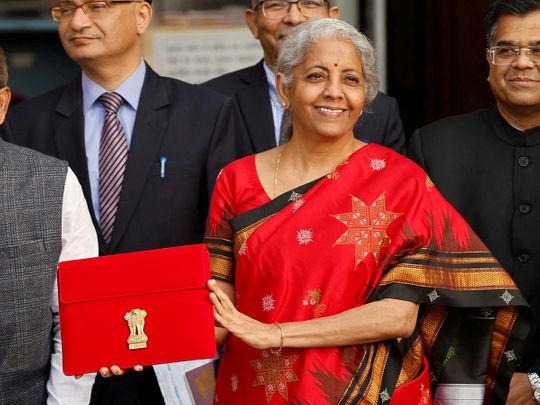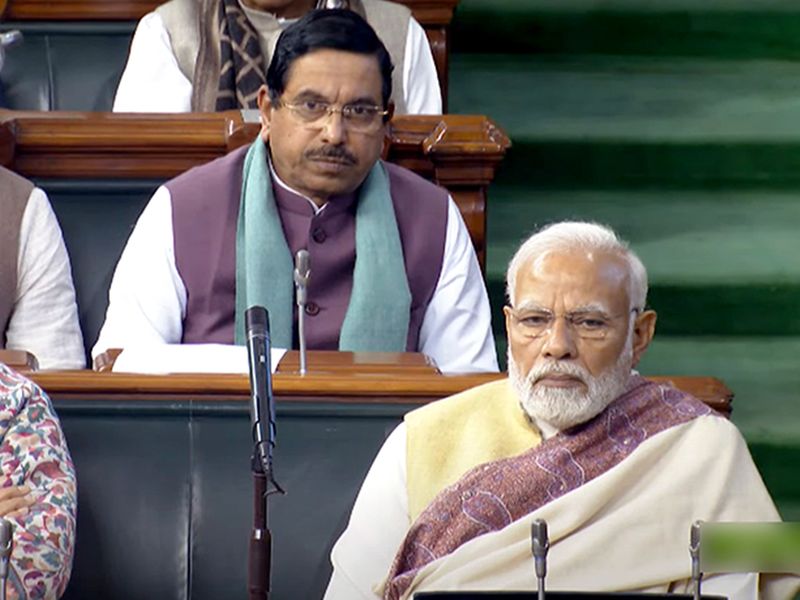
New Delhi / Dubai: India is raising its capital investments in the 2023-24 financial year to a substantial Rs10 trillion ($122.2 billion) — that’s 3 times the level in 2019-20 — as the government goes in for a growth budget.
The Rs10 trillion capital investment represents 3.3 per cent of GDP.
“In spite of the massive slowdown globally caused by COVID-19 and the war, the Indian economy is on the right track,” said Nirmala Sitharaman, the Finance Minister.
An 'inclusive' Budget
“I would term it as an ‘inclusive’ budget that has tried to take into consideration all segments of society and priority sectors,” said Yusuffali M.A., Chairman of Lulu Group. “For me, the key takeaways are the major initiatives announced in strengthening connectivity, food security and skill development sectors.

The construction of 50 new airports and development of water-routes is sure to have major impact on the socio-economic fabric of India and will further boost our position as a dream destination for global businesses and investors.
The Lulu founder, incidentally, is a promoter shareholder in Kochi’s Nedumbassery Airport and also the one in Kannur. “I am sure Budget 2023-24 will further strengthen Indo-Gulf business relationship and bring in more investments into the country to benefit our economic development and employment sector.”

Record capital investment outlays, incentives for manufacturing in India and infrastructure push are clear indications of how India is preparing itself as a global hub for services and manufacturing. Focus on capacity building, capital investments, infrastructure push, friendly tax regime will certainly attract global investors.
Stocks of key industry verticals such as tourism are pushing higher. "Anything that is retail focussed should be getting a boost in the days ahead," said a market watcher. "The big bet investors will make is that this is a consumer-friendly budget. Ahead of an election year, this is a feel-good one."
The budget also outlines creating an ‘urban infrastructure fund’ of Rs100 billion a year as India aims to make it smoother for global businesses seeking to set up manufacturing/logistics hubs in the country. Post-pandemic, countries are competing to take in such possibilities as businesses realise that consolidating all of their overseas interests in single markets could create supply chain logjams.
Personal income tax
In latest budget, India raises exemption for income tax rebate to Rs700,000 from Rs500,000.
India reduces maximum upper tax to 39 per cent from 42 per cent, which is ‘one of the highest in the world’.
There are major shifts in the income tax burden of individuals. Reduction of up to 25 per cent are being offered depending on the individual’s annual income. For instance, someone generating Rs1.5 million gets to pay 10 per cent of it, down 25 per cent from the previous regime.

The setting up of Agriculture Accelerator Fund will encourage startups in rural areas and is aimed at bringing innovative and affordable solutions to farmers. ‘Shree Anna’ will be the global hub for millets such as jowar, ragi, bajra, kuttu, etc.. Organic farming is also incentivised and farmers are encouraged to adopt natural farming.
2. Rs300,000 to Rs600,000 - 5%
3. Rs600,000 to Rs900,000 - 10%
4. Rs900,000 to Rs1.2 million - 15%
5. Rs1.2 million to Rs1.5 million- 20%
6. Above Rs1.5 million - 30%

India is third largest eco-system for start-ups globally…
No NRI mention
Leading lights in UAE’s Indian business circles also point to the fact that NRIs have not been given any mention in Budget 2023-24.
“In the last year of the current Lok Sabha, the Budget finds NRIs don’t mean anything to their motherland,” said Ram Buxani, Chairman of Cosmos-ITL Group. “There is not even a hollow mention of NRIs in the text. The recent Pravasi Bharati award was given to just one person out of 4 million Indian expatriates living in the region.

Except for that, there will be a lot of appreciation for the inclusive budget otherwise. This year’s budget is the voter’s budget. And NRIs don’t have a vote in their country.
“Except for that, there will be lot of appreciation for the inclusive budget otherwise. This year’s budget is voter’s budget. And NRIs don’t have vote in their country.”
“The Indian Diaspora of 40 million is the largest; their remittance was $100 billion in 2022 which is the highest remittance,” said K. V. Shamsudheen, Director of Barjeel Geojit Financial Service.
“At least a Systematic Investment Plan (SIP) in mutual funds could be propagated by the government so that these segments of NRIs could lead a happy life. A monthly investment of Rs10,000 for ten years in a mutual fund will be at least Rs2.7 million after 10 years, which will give a monthly systematic withdrawal of Rs18,000.”

And 75 per cent is from the 60 per cent of the lower and middle-income segment of the Indian diaspora living in MENA. They are remitting the maximum possible and the majority of them return with an empty hand. We have been requesting to start an investment scheme to safeguard the future of these segments.

The ‘Saptarishi’ way
While the FM Nirmala made a point of committing more into India’s villages/tribal zones, there are 7 overarching targets for growth and boost development:
- Inclusive development;
- Reaching the ‘last mile’;
- Infra investment;
- Unleashing potential;
- ‘Green’ growth;
- Youth power; and
- Financial sector
Lab grown diamonds
India is also planning a quick move into the still emerging ‘lab grown diamond’ space, through special incentives. More jewellery retailers are using such diamonds as opposed to natural ones, and there is also a growing acceptance among consumers, especially among a younger buyer profile.

The FM’s announcement to further upgrade the 'DigiLocker' platform will give a big boost to user documentation, support the onboarding efforts of NBFCs and fintechs driving financial inclusion among the country’s MSMEs and underbanked population.

We were hoping for concessions for NRIs residing abroad like reduction on TDS for those who have a source of income in India and are required to pay taxes in the country they reside in. The need to have more hospitals and healthcare facilities in rural and suburban areas to meet the rising demand remains untouched. Hope the government would put more focus on PPP to address this.
The budget also comes as Modi takes the global stage with India's presidency of the Group of 20 nations as he pushes an ambition to turn the nation into the world's third-largest economy before the end of the decade.
"G20 presidency gives us a unique opportunity to strengthen India's role in global order," Sitharaman said. "Our vision for the 'Amrit Kaal' includes technology driven and knowledge based economy with strong public finances and a robust financial sector," she said, referring to the next 25 years leading to India's 100 years of independence, which the government touts as the period of nectar.

From a jewellery industry aspect, our key recommendation to reduce import duty for gold from 15% to cure illegal imports has not been addressed - and that's quite disappointing. We hope that this request will be taken into consideration and addressed in the best possible manner
‘Polluting’ vehicles
The Budget is going for green with renewed push. Polluting vehicles are being given short shrift, with a new programme announced to turn older government-owned vehicles into scarp.

It is encouraging to see the Budget outlines measures focusing on sectors that will be the driving force of India’s economy and achieve the $5 trillion mark by 2025. The emphasis on green growth, youth empowerment, and establishment of the centers of excellence in ArI will ensure that the country becomes a shining example of a global hub of excellence.
"Government will primarily focus boosting infrastructure with 50 new airports and a massive boost Rs2.4 trillion allocation for Railways," said Neelesh Bhatnagar, the Dubai-based founder of NB Ventures.

"Startups have been encouraged to carry forward losses for 10 years with special focus on agritech startups. I don’t see any benefits for NRIs."

The Budget is focusing on tourism in a big way - domestic tourism is being given special focus through 'Dekho Apna Desh,
Interest-free loans
Indian states will be offered interest-free loans, and these need to be used in tandem with their own capex schemes.
The Budget lays much emphasis on building the infrastructure of the country, with emphasis on last-mile connectivity," said Anuj Puri, Chairman of Anarock, the real estate consultancy. "Improved urban infrastructure will provide further impetus to Tier 2 and 3 cities.
"The unwavering focus on infrastructure will indirectly drive real estate growth over the next one year. The tourism sector also has something to cheer for as the budget aims to boost domestic and international tourism."

The new measures announced in the Union Budget 2023-24 may certainly help unleash Indian economy’s potential. However, from a real estate point of view, there were no major direct announcements that could be seen as immediate booster shots

The reduction in custom duty on parts for mobile phones would go long way in enhancing India’s export of these. The Budget proposal to extend the same facilities to other electronics like TVs is welcome.
Duty cuts on TV, mobile parts
Domestic mobile phone production is getting more support, through reduction in custom duty. This has been one area where India has made headway of late, a fact emphasised by Apple widening its production of iPhones.
TV production too is getting the same treatment, as India spots an opportunity to deepen its manufacturing base across sectors and categories, especially in high-end gadgets.
“The economic growth indicated of 6.8 per cent is realistic - and it will still be higher that most countries,” said Tariq Chauhan, CEO of EFS Group.

The increase in capital expenditure with a focus on communications, road, and water resources, will give a significant boost to infrastructure spending. That’s a definite positive of Budget 2023-24.
The latest Budget was coined as predominantly a ‘middle-class bonanza’, while also deemed inclusive to schemes catering to women and the elderly. As a result, five income tax measures were announced on Wednesday in a huge relief to average Indian income earners.
A clear highlight was the announcement of an increase in the income tax rebate limit from Rs500,000 to Rs700,000 stating that the new tax regime will now be the default tax regime. But what does this mean?
A tax rebate is a refund that you are eligible for in case the taxes you pay exceed your liability. For instance, if your tax liability amounts to Rs30,000, but the government is paid taxes amounting to Rs40,000 on your behalf, you qualify for a rebate or refund for the excess.
When putting the current hike in tax rebate limit to Rs700,000 into perspective, people earning up to Rs700,000 annually will not pay any income tax in the new tax regime as the personal income tax rebate limit has been increased to Rs700,000 from Rs500,000.
Additionally, the government also proposed a change the tax structure in this regime by reducing the number of tax slabs to five (from six) and increasing the tax exemption limit to Rs300,000 (from Rs250,000 earlier). The government offered to make the new tax regime as the default option.
However, people will further have the option of old tax regime, which allows PPF, NPS and some other concessions. What this means is that people above Rs700,000 annual income will have to prudently choose between the new and old regimes.

To put it simply, while the Budget was broadly guided by broad principles including housing for all, poverty reduction, healthcare facilities in villages, and steps to boost manufacturing, when it comes to whether or not Non-Resident Indians (NRIs) stand to benefit, there was barely any mention.















